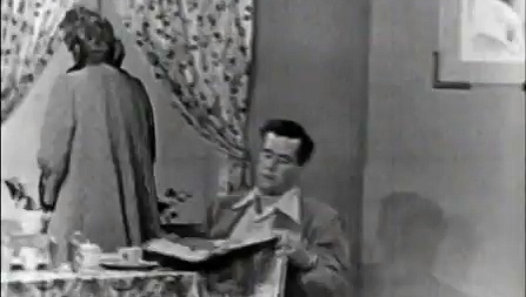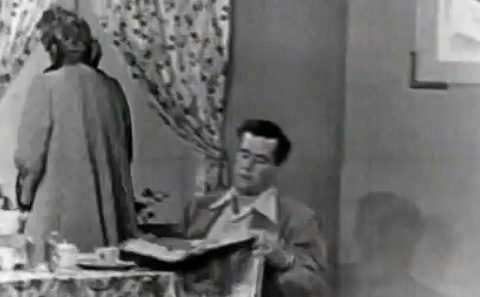

March 2, 1951…Desilu Empire Begins With The “I Love Lucy” Pilot …
March 2, 1951…Desilu Empire Begins With The “I Love Lucy” Pilot
On March 2, 1951, the pilot episode for “I Love Lucy” was shot at the CBS Columbia Square Studios on Sunset Blvd. in Hollywood. It was shot with three RCA TK30 Image Orthicon cameras and recorded via kinescope. When Desi Arnaz and Lucille Ball saw the playback of the kine film, they knew then and there what they wanted to do.
CBS and the prospective sponsors for the show wanted it to be produced in New York. Arnaz and Ball knew that if they did it that way, they would have to do the show live, and the west coast would have to see a kinescope playback.
Ball, having already achieved stardom in films, did not like the way the show would look to her friends in Hollywood. This was the major determining factor in the decision to shoot the show on film in Hollywood. Due to union contracts, CBS could not shoot a film production in it’s television studios, so, in order get the show on the air, Ball and Arnaz would have to become the producers and do it “off the lot”.
Here is the first few minutes of the pilot recorded at Columbia Square.
This would be the start of Desilu Productions and give Desi and Lucy a lot more control of the content, AND…a film library that could later be syndicated, leased or sold. Had the show been done in New York, it would have gone the way of so many other great shows that are now lost to us as many kine libraries were dumped along the way.
The kinescope of the pilot was thought lost until a 16mm copy was discovered in the effects of Pepito Perez. His estate provided the film to CBS, and the network aired it in April 1990, almost exactly 39 years after it was made. Perez is the famous Spanish clown that appears in this pilot.
Writers Jess Oppenheimer, Madelyn Pugh and Bob Carroll, Jr. had worked with Ball on “My Favorite Husband” and had also written the Ball-Arnaz vaudeville routine that set up the pilot. They knew exactly how to exploit Ball’s personality and mastery of physical comedy.
At this link is a wonderful six part Emmy TV Legends interview from the Archive of American Television with both Bob Carroll and Madelyn Pugh. Just under the video frame, there is a box with tabs on the top with names like Highlights, Interview, Shows, People, etc. Click the Interview tab and at the top of Part 3, they describe bringing the show to television.
http://www.emmytvlegends.org/interviews/people/madelyn-pugh-davis#
Now, back to the pilot. The episode takes place on only two sets: the Ricardo’s living room and the nightclub where Ricky performs. This is the first iteration of the premise that would drive the show’s spectacular 194-episode run: A TV producer is coming to see Ricky perform. Lucy wants to be part of the act. Hilarity ensues.
Fred and Ethel Mertz don’t appear in the pilot, which allows a couple of extra minutes for Arnaz to perform with his band. The plot has it that Ricky has booked Pepito the Spanish Clown to appear with him at the club that night. When Pepito suffers a laugh-out-loud accident, Lucy dons his costume and takes his place at the nightclub, performing a comical routine with a trick cello. Ball and Arnaz had been married for a decade and had polished their routine during the road tour, and their timing is superb.
Ball was five months pregnant at the time the pilot was produced, which was concealed by layered costumes, including an absurdly large bathrobe.
The hit radio show starring Ball, “My Favorite Husband” ended its run a month after the “I Love Lucy” pilot was produced and the TV show was picked up by tobacco giant Philip Morris. In October 1951, seven months after the pilot was shot, “I Love Lucy” debuted on CBS, launching Ball into a quarter-century TV career that remains in broadcast rotation to this day.
Several of the gags used in the pilot were recycled into ”The Audition,” which was Episode 6 of the first season and in the second season, Pepito the Spanish Clown (Pepito Perez, an international star and close friend of Arnaz) returned to the show in “Lucy’s Show-Biz Swan Song.”
There is yet another interesting twist to this pilot story…the director!
This Lucy pilot was directed by Ralph Levy. You may not know the name, but you know his work. Among other things, Ralph Levy directed the “The Jack Benny Show”, “Burns And Allen”, “The Ed Wynn Show” and many more. In the 1950s and ’60s, he was CBS’s directing star.
Levy was the network’s first choice to direct “I Love Lucy”, but he begged off: he knew he already had his hands full with Benny, Burns and Allen.
Levy won his first Emmy for his work with Jack Benny and his second Emmy two years later for the first “Bob Newhart Show”, which was a weekly half-hour of stand-up comedy and variety.
Levy also directed the pilots of “The Beverly Hillbillies” and “Green Acres”, and two seasons of “Petticoat Junction”…all for his friend Paul Henning, one of George Burns’ writers who had since become a successful producer.
Ralph later attempted to do dramas…programs like “Hawaii Five-O” and feature films, but somehow, his heart was not in these projects: he missed the live audiences that early television and the theater had provided.
Levy spent several years in England in the 1970s, working for BBC Television, and taught TV production classes at Cal State Northridge and Loyola Marymount University. He retired to Santa Fe, New Mexico in 1981. Enjoy and share! -Bobby Ellerbee
This was the first three camera show to use dollys…the previous filmed shows had the cameras locked down. This was also the first series that played the same episode on the east coast the same night as the west coast. A 35mm print was projected in sync with a 16mm back-up print so if the 35 broke, they could switch to the 16. If Desi had only not sold the films back to CBS when he retired, imagine how wealthy the family would have been.
I met Greg Oppenheimer a few weeks ago (son of Jess). The pilot as released on BluRay IS from the 35mm kinescope camera negative. Really stunning quality.
Technically, “I Love Lucy” was NOT the first TV program to be filmed in front of a live audience. That distinction goes to “You Bet Your Life” with Groucho Marx. And, “Lucy” was not the first sitcom to use a multi-camera format. The syndicated sitcom “Jackson and Jill” did so when it first aired in 1949–although that show used 16mm film, as opposed to the 35mm used for “Lucy.”
Desi Arnaz would have turned 100 years old today. The first season blu-ray of ILL has the pilot from a “recently discovered” 35mm kinescope (so they say) and the quality is really good. Or the producers used modern technology to remaster and upgrade the kine. Also, Ralph Levy passed away on October 15, 2001 – the 50th anniversary of the premiere of I Love Lucy. Wonderful post!!!!